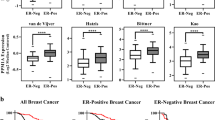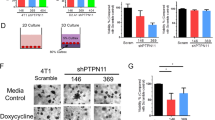Abstract
The proto-oncogene ErbB2 is known to be amplified and to play an important role in the development of about one-third of human breast cancers. Phosphatidylinositol 3-kinase (PI3K), which is often activated in ErbB2-overexpressing breast cancer cells, is known to regulate cell proliferation and cell survival. Selective inhibitors of the PI3K pathway were used to assess the relevance of PI3K signaling in the anchorage-independent growth of a series of human mammary carcinoma cell lines. Wortmannin, LY294002, and rapamycin at concentrations that did not affect MAPK phosphorylation but substantially inhibited PI3K, Akt, and p70S6K significantly suppressed the soft agar growth of tumor cell lines that overexpress ErbB2 but not the growth of tumor lines with low ErbB2 expression. A similar growth inhibition of ErbB2-overexpressing carcinoma lines was observed when a dominant negative p85PI3K mutant was introduced into these cells. Forced expression of ErbB2 in breast cancer lines originally expressing low ErbB2 levels augmented receptor expression and sensitized those lines to LY294002- and rapamycin-mediated inhibition of colony formation. Furthermore, treatment with LY294002 resulted in the selective increase of cyclin-dependent kinase inhibitors p21Cip1 or p27Kip1 and suppression of cyclin E-associated Cdk2 kinase activity in ErbB2-overexpressing lines, which may account for their hypersensitivity toward inhibitors of the PI3K pathway in anchorage-independent growth. Our results indicate that the PI3K/Akt/p70S6K pathway plays an enhanced role in the anchorage-independent growth of ErbB2-overexpressing breast cancer cells, therefore providing a molecular basis for the selective targeting of this signaling pathway in the treatment of ErbB2-related human breast malignancies.
This is a preview of subscription content, access via your institution
Access options
Subscribe to this journal
Receive 50 print issues and online access
$259.00 per year
only $5.18 per issue
Buy this article
- Purchase on Springer Link
- Instant access to full article PDF
Prices may be subject to local taxes which are calculated during checkout






Similar content being viewed by others
Abbreviations
- EGFR:
-
epidermal growth factor receptor
- PI3K:
-
phosphatidylinositol 3-kinase
- RPTK:
-
receptor protein tyrosine kinase
- MAPK:
-
mitogen activated protein kinase
- PKB:
-
protein kinase B
- Cdk:
-
cyclin-dependent kinase
References
Ahmed NN, Grimes HL, Bellacosa A, Chan TO, Tsichlis PN . 1997 Proc. Natl. Acad. Sci. USA 94: 3627–3632
Amundadottir LT, Leder P . 1998 Oncogene 16: 737–746
Alimandi M, Romano A, Curia MC, Muraro R, Fedi P, Aaronson SA, Di Fiore PP, Kraus MH . 1995 Oncogene 10: 1813–1821
Arcaro A, Wymann MP . 1993 Biochem. J. 296: 297–301
Brunet A, Bonni A, Zigmond MJ, Lin MZ, Juo P, Hu LS, Anderson MJ, Arden KC, Blenis J, Greenberg ME . 1999 Cell 96: 857–868
Cardone MH, Roy N, Stennicke HR, Salvesen GS, Franke TF, Stanbridge E, Frisch S, Reed JC . 1998 Science 282: 1318–1321
Casagrande F, Bacqueville D, Pillaire MJ, Malecaze F, Manenti S, Breton-Douillon M, Darbon JM . 1998 FEBS Lett. 422: 385–390
Collado M, Medema RH, Garcia-Cao I, Dubuisson ML, Barradas M, Glassford J, Rivas C, Burgering BM, Serrano M, Lam EW . 2000 J. Biol. Chem. 275: 21960–21968
Chung J, Kuo CJ, Crabtree GR, Blenis J . 1992 Cell 69: 1227–1236
Colomer R, Lupu R, Bacus SS, Gelmann EP . 1994 Br. J. Cancer 70: 819–825
Datta SR, Dudek H, Tao X, Masters S, Fu H, Gotoh Y, Greenberg ME . 1997 Cell 91: 231–241
Di Fiore PP, Pierce JH, Kraus MH, Segatto O, King CR, Aaronson SA . 1987 Science 237: 178–182
Downward J . 1998 Science 279: 673–674
Dufner A, Thomas G . 1999 Exp. Cell Res. 253: 100–109
Fruman DA, Meyers RE, Cantley LC . 1998 Rev. Biochem. 67: 481–507
Guy CT, Webster MA, Schaller M, Parsons TJ, Cardiff RD, Muller WJ . 1992 Proc. Natl. Acad. Sci. USA 89: 10578–10582
Harari D, Yarden Y . 2000 Oncogene 19: 6102–6114
Houston SJ, Plunkett TA, Barnes DM, Smith P, Rubens RD, Miles DW . 1999 Br. J. Cancer 79: 1220–1226
King CR, Kraus MH, Aaronson SA . 1985 Science 229: 974–976
Kraus MH, Popescu NC, Amsbaugh SC, King CR . 1987 EMBO J. 6: 605–610
Kraus MH, Fedi P, Starks V, Muraro R, Aaronson SA . 1993 Proc. Natl. Acad. Sci. USA 90: 2900–2904
Kuo CJ, Chung J, Fiorentino DF, Flanagan WM, Blenis J, Crabtree GR . 1992 Nature 358: 70–73
Lane HA, Beuvink I, Motoyama AB, Daly JM, Neve RM, Hynes NE . 2000 Mol. Cell. Biol. 20: 3210–3223
Liu D, Rutter WJ, Wang LH . 1993 J. Virol. 67: 9–18
Medema RH, Kops GJ, Bos JL, Burgering BM . 2000 Nature 404: 782–787
Ozes ON, Mayo LD, Gustin JA, Pfeffer SR, Pfeffer LM, Donner DB . 1999 Nature 401: 82–85
Pierce JH, Arnstein P, Di Marco E, Artrip J, Kraus MH, Lonardo F, Di Fiore PP, Aaronson SA . 1991 Oncogene 6: 1189–1194
Price DJ, Grove JR, Calvo V, Avruch J, Bierer BE . 1992 Science 257: 973–977
Robinson MJ, Cobb MH . 1997 Curr. Opin. Cell Biol. 9: 180–186
Roh H, Pippin JA, Green DW, Boswell CB, Hirose CT, Mokadam N, Drebin JA . 2000 Oncogene 19: 6138–6143
Romashkova JA, Makarov SS . 1999 Nature 401: 86–90
Sherr CJ, Roberts JM . 1999 Genes Dev. 13: 1501–1512
Slamon DJ, Clark GM, Wong SG, Levin WJ, Ullrich A, McGuire WL . 1987 Science 235: 177–182
Stambolic V, Suzuki A, de la Pompa JL, Brothers GM, Mirtsos C, Sasaki T, Ruland J, Penninger JM, Siderovski DP, Mak TW . 1998 Cell 95: 29–39
Vlahos CJ, Matter WF, Hui KY, Brown RF . 1994 J. Biol. Chem. 269: 5241–5248
Yang HY, Zhou BP, Hung MC, Lee MH . 2000 J. Biol. Chem. 275: 24735–24739
Yano H, Nakanishi S, Kimura K, Hanai N, Saitoh Y, Fukui Y, Nonomura Y, Matsuda Y . 1993 J. Biol. Chem. 268: 25846–25856
Yokota J, Yamamoto T, Toyoshima K, Terada M, Sugimura T, Battifora H, Cline MJ . 1986 Lancet 1: 765–767
Yu D, Jing T, Liu B, Yao J, Tan M, McDonnell TJ, Hung MC . 1998 Mol. Cell 2: 581–591
Yu D, Hung MC . 2000 Oncogene 19: 6115–6121
Zhou BP, Hu MC, Miller SA, Yu Z, Xia W, Lin SY, Hung MC . 2000 J. Biol. Chem. 275: 8027–8031
Zhou BP, Liao Y, Xia W, Spohn B, Lee MH, Hung MC . 2001 Nat. Cell Biol. 3: 245–252
Acknowledgements
We are grateful to Dr Mien-Chie Hung (M. D. Anderson Cancer Center, Houston, TX, USA) for providing the ErbB2 expression plasmid and Dr Julian Downward (Imperial Cancer Research Fund, London, UK) for providing the Δp85 plasmid. This work was supported by National Institute of Health grants CA29339 and CA55054. U Hermanto was supported in part by Department of Defense Breast Cancer Predoctoral Training Program Grant DAMD 17-94-J-4111 and the Mount Sinai School of Medicine Medical Scientist Training Program, National Institute of General Medical Sciences Grant T32GM07280.
Author information
Authors and Affiliations
Corresponding author
Rights and permissions
About this article
Cite this article
Hermanto, U., Zong, C. & Wang, LH. ErbB2-overexpressing human mammary carcinoma cells display an increased requirement for the phosphatidylinositol 3-kinase signaling pathway in anchorage-independent growth. Oncogene 20, 7551–7562 (2001). https://doi.org/10.1038/sj.onc.1204964
Received:
Revised:
Accepted:
Published:
Issue Date:
DOI: https://doi.org/10.1038/sj.onc.1204964
Keywords
This article is cited by
-
Fatty acid synthase regulates estrogen receptor-α signaling in breast cancer cells
Oncogenesis (2017)
-
Obvious and Hidden Reasons of Breast Cancer Cell Sensitivity to Antitumor RNase
BioNanoScience (2016)
-
Design optimization and characterization of Her2/neu-targeted immunotoxins: comparative in vitro and in vivo efficacy studies
Oncogene (2014)
-
LOXL2 induces aberrant acinar morphogenesis via ErbB2 signaling
Breast Cancer Research (2013)
-
HRG-β1-driven ErbB3 signaling induces epithelial–mesenchymal transition in breast cancer cells
BMC Cancer (2013)



